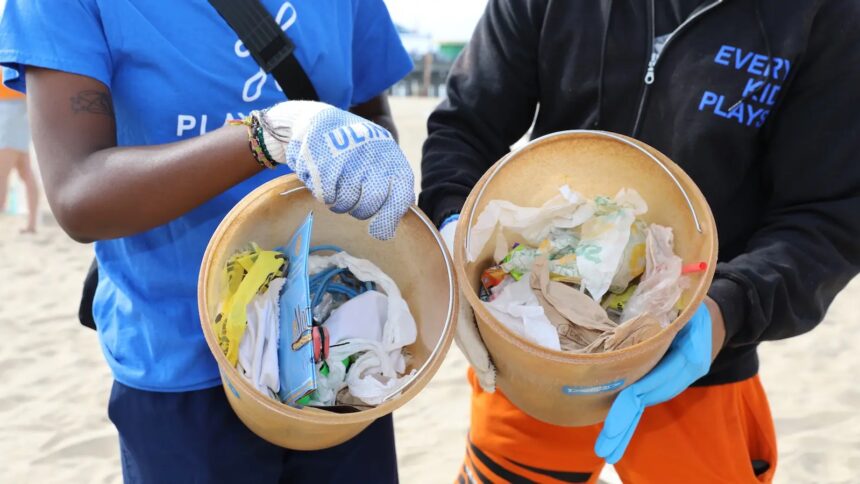The rain is pummeling the shoreline when I arrive at Kitsilano Beach. In the gray morning light, Denise Wong, a marine conservation technician with the Vancouver Aquatic Ecosystems Research Centre, is already knee-deep in her work – quite literally. She’s collecting microplastics samples in the tidal zone, methodically sifting through sand and debris.
“Five years ago, this beach would yield at least three dozen plastic bags during a standard collection day,” Wong tells me, her rain jacket slick with moisture. “Today, I’m lucky if I find two.”
This dramatic reduction in plastic bag litter isn’t just anecdotal. A comprehensive new study published in the Canadian Journal of Environmental Sciences confirms what environmental advocates have long suspected: plastic bag bans significantly reduce environmental pollution.
The peer-reviewed study, conducted over three years across 17 Canadian municipalities, found that communities with plastic bag bans experienced a 71% reduction in bag-related litter compared to those without such policies. The research represents the most extensive analysis of plastic bag legislation effectiveness in North America to date.
“The evidence is clear and compelling,” explains Dr. Michael Cheng, lead researcher and environmental policy expert at the University of British Columbia. “When properly implemented and enforced, plastic bag bans lead to measurable decreases in environmental contamination.”
I first witnessed this transformation while reporting on Vancouver’s single-use plastic reduction strategy in 2018. Back then, environmental groups faced significant pushback from industry representatives who questioned whether bans would create meaningful environmental benefits or simply inconvenience consumers.
The federal government’s nationwide ban on manufacturing and importing single-use plastics came into effect in December 2022, with a prohibition on their sale following in December 2023. But individual municipalities had been implementing their own regulations for years, creating a natural experiment for researchers to study.
“What makes this study particularly valuable is that we were able to compare similar communities with and without bans,” says Cheng. “We controlled for factors like population density, coastal proximity, and tourism impacts to isolate the effect of the bans themselves.”
The research methodology involved quarterly litter audits conducted using standardized protocols developed by Environment and Climate Change Canada. Researchers counted and categorized all visible plastic waste within designated collection zones, with special attention paid to single-use plastic bags.
But beyond the numbers, the study reveals a cultural shift. In Victoria, which implemented one of Canada’s earliest municipal bans in 2018, researchers documented changing consumer behaviors through surveys and interviews.
“Initially, there was resistance,” remembers Caroline Tai, Victoria’s environmental services coordinator, who was not involved in the study. “But we’ve seen a complete normalization of reusable bags. What was once seen as an inconvenience is now just part of daily life.”
The findings challenge persistent industry claims that plastic bag bans merely shift environmental problems rather than solving them. Critics have argued that alternatives like paper bags or thicker “reusable” plastic bags might have greater carbon footprints or still end up as waste.
The study addressed these concerns by examining broader waste streams and found that while paper bag usage did increase initially in communities with plastic bag bans, this effect diminished over time as consumers adapted to reusable alternatives. Moreover, the total volume of bag-related waste decreased significantly in all ban communities.
“We did see some substitution effects in the first 6-12 months after implementation,” acknowledges Dr. Cheng. “But the long-term trend shows a clear net benefit for waste reduction.”
For Indigenous coastal communities, many of whom implemented bans before provincial or federal regulations, the results validate traditional knowledge about protecting marine ecosystems.
“We’ve been saying for generations that these materials don’t belong in our waters,” says Megan Humchitt, a Heiltsuk Nation councilor from Bella Bella, BC. “Our community banned plastic bags in 2017 because we were seeing firsthand how they affected marine life and our food systems.”
The Heiltsuk Nation’s territory in the Great Bear Rainforest contains some of Canada’s most productive and diverse marine ecosystems. When I visited in 2019 to report on their environmental initiatives, community members showed me how plastic waste had infiltrated even the most remote shorelines.
The study found coastal Indigenous communities that implemented bans experienced among the most dramatic reductions in plastic bag pollution—with decreases of up to 89% in some locations.
While the research confirms the effectiveness of bans, it also highlights areas for improvement. Communities with robust education campaigns and those providing affordable access to reusable alternatives showed better results than those simply implementing prohibitions.
The findings arrive at a critical moment. The federal government faces a legal challenge from plastic manufacturers who claim the designation of plastic as “toxic” under the Canadian Environmental Protection Act oversteps regulatory authority. A Federal Court ruled against the government in November 2023, though Ottawa has appealed the decision.
Meanwhile, Environment and Climate Change Canada estimates that Canadians use approximately 15 billion plastic bags annually, with millions ending up in waterways. Plastic bags can take hundreds of years to decompose, breaking down into microplastics that contaminate water systems and enter food chains.
Back at Kitsilano Beach, Wong carefully catalogs the day’s microplastic samples, which will be analyzed at UBC’s oceanography lab. While plastic bags may be less visible on our shorelines, the legacy of decades of plastic pollution remains.
“These bans are just the beginning,” Wong says, gesturing toward the water. “But they prove that policy changes can make a real difference. The study confirms what we’re seeing in the field—when we make better choices on land, our oceans benefit.”
As I prepare to leave, a family arrives at the beach, their reusable shopping bags repurposed to carry picnic supplies. Their daughter runs ahead, bucket in hand, ready to explore tidepools. It’s a small moment that captures something significant: how quickly new habits can become second nature, and how policy can help shape a different relationship with our environment.






